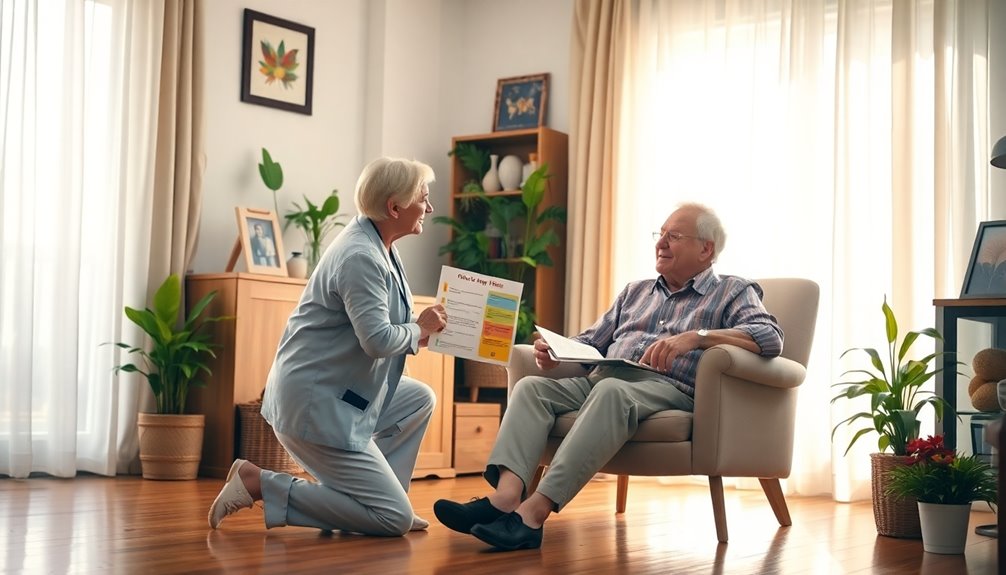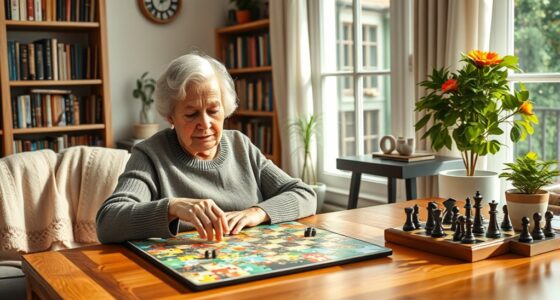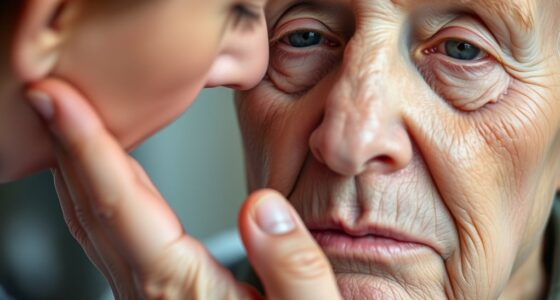To guarantee comfort and safety for the elderly, focus on convenience and layouts that allow easy navigation. Guarantee ample lighting to reduce fall risks and consider bathroom safety upgrades like grab bars. Pay attention to furniture height for comfort and keep pathways clear with non-slip surfaces. Have emergency contacts easily accessible and create social spaces for interaction. Don't forget medications—keep them organized. There's plenty more to learn about enhancing their well-being and independence.
Key Takeaways
- Prioritize safety by ensuring clear pathways and installing grab bars in bathrooms and near stairs to reduce fall risks.
- Maintain a hygienic living space by regularly cleaning and inspecting flooring to prevent dirt buildup and hazards.
- Create a routine that includes enjoyable activities and regular physical exercise to enhance emotional well-being and mood.
- Foster social engagement by organizing gatherings, encouraging visits from family, and utilizing technology for virtual connections.
- Involve seniors in decision-making about their living environment and daily activities to promote autonomy and confidence.
Convenience and Layout

When designing a living space for seniors, it's essential to prioritize convenience and layout to enhance safety and mobility. A well-planned home environment can greatly improve physical health by reducing the risk of falls.
Start by creating flexible layouts that allow easy navigation, especially for those with mobility challenges. Make certain walkways are at least 36 inches wide, free from obstacles, and decluttered to maintain clear pathways.
If possible, opt for a single-story home to eliminate the dangers associated with stairs. Installing handrails in stairwells and hallways offers additional support.
Incorporating these elements into your care plan not only promotes independence but also guarantees a safer living space tailored to the needs of seniors.
Enough Lighting

A well-designed living space goes beyond just convenience and layout; adequate lighting plays an essential role in ensuring safety for seniors. Proper lighting is vital for preventing accidents at home, as studies show well-lit environments can reduce the risk of falls by up to 50%.
Installing brighter bulbs, like LED, enhances visibility, with at least 1,000 lumens recommended for key areas. Task lighting, including reading lamps or under-cabinet lights, can help with specific activities, reducing eyestrain and mishaps.
Don't forget nightlights in hallways and bathrooms to improve nighttime safety, making it easier to navigate without stumbling. Regularly check and replace burnt-out bulbs to maintain consistent lighting, as poor visibility can lead to disorientation and increased risks for those with visual impairment.
Focus on Bed Height

When it comes to your loved one's comfort and safety, bed height matters.
Choosing a bed that's the right height can make getting in and out easier, reducing the risk of falls.
Consider options like adjustable beds to enhance accessibility and support their mobility needs.
Optimal Bed Height
Choosing the right bed height is essential for seniors' safety and comfort. The ideal bed height ranges from 16 to 24 inches off the ground. This allows seniors to sit on the edge with their feet flat on the floor, making it easier to shift from sitting to standing and helping to reduce the risk of falls.
If you're caring for someone who uses a wheelchair, aim for a bed height that matches the typical seat height of about 18 inches. If a bed is too low, consider using bed risers to achieve the ideal height.
Adjustable Bed Options
Adjustable beds offer a versatile solution for seniors who need tailored comfort and ease of access.
With customizable heights, you can find the perfect position that enhances your physical well-being. Many adjustable beds come with features like head and foot elevation, which can alleviate pressure on joints and improve circulation, essential for managing health conditions. Additionally, proper medication management is vital for seniors, especially those dealing with chronic illnesses, to ensure they are receiving optimal care. Incorporating smart home technology can also provide added convenience and safety for elderly individuals.
Ideally, your bed height should match your wheelchair seat, making it easier to shift between the two. This thoughtful adjustment not only boosts your quality of life but greatly reduces the risk of falls, allowing you to get in and out of bed more safely.
Plus, with remote controls or smartphone apps, you can adjust your sleeping position independently and effortlessly. Additionally, proper diet is crucial for overall health, so considering a balanced intake can further enhance your well-being.
Safety and Accessibility
Guaranteeing your bed is the right height can greatly improve safety and accessibility for elderly individuals. Aim for a bed height between 18 to 24 inches from the floor. This minimizes fall risks and makes getting in and out of bed easier.
If you're caring for someone who uses a wheelchair, match the bed height to the wheelchair seat to facilitate smooth transfers. Adjustable beds can also enhance comfort by allowing elevation for head or legs, which is beneficial for conditions like arthritis.
Bathroom Safety
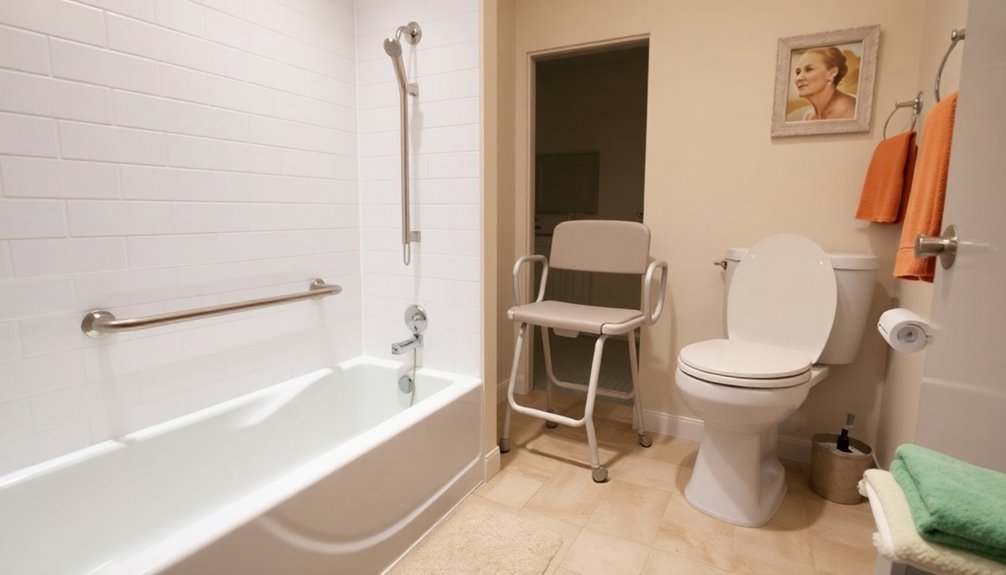
Bathroom safety is essential for elderly individuals, as even minor slips can lead to serious injuries.
To enhance safety, install grab bars near the toilet, shower, and bathtub; they provide vital support and help prevent falls. Using non-slip mats inside the shower and near the tub greatly reduces the risk of slipping on wet surfaces. Regular exercise and motor skills development can also contribute to better balance and stability, further reducing the risk of falls. Additionally, incorporating rehabilitative alimony can relieve financial stress, allowing families to invest in necessary safety measures.
Consider a walk-in shower to improve accessibility, making it easier for those with mobility challenges. Make sure your bathroom is well-lit, as proper lighting aids navigation and reduces accidents during nighttime visits.
Regularly check for hazards like loose tiles or clutter, and address any maintenance issues promptly to maintain a safe bathing environment. Additionally, ensuring that toilets are equipped with dual-flush toilet systems can promote water efficiency and may reduce the likelihood of clogs, enhancing overall safety.
Prioritizing these tips can make a considerable difference in bathroom safety.
Be Cautious About Furniture and Flooring

When you choose furniture and flooring for seniors, focus on safety and comfort.
Select pieces with a proper height, rounded edges, and non-slip surfaces to reduce hazards.
It's also essential to keep pathways clear, making navigation easier and safer for everyone.
Safe Furniture Selection
Choosing the right furniture can greatly enhance safety and comfort for seniors in their living spaces.
When it comes to safe furniture selection, prioritize comfortable seating at appropriate heights to minimize strain for older adults. Opt for rounded-edged furniture to reduce the risk of injury from falls or collisions, especially in tighter areas.
Consider non-slip carpets or low-pile rugs to provide better stability and help reduce trip hazards. Additionally, incorporating accessible design features can further improve safety and ease of movement. Arrange furniture to create wide pathways, allowing easy movement for seniors using mobility aids like walkers or wheelchairs.
Regularly assess your furniture's condition and replace any items showing wear or damage, ensuring a safe and comfortable environment for your loved ones. Additionally, choosing furniture with pet-friendly fabrics can help maintain cleanliness and reduce the accumulation of pet hair in shared living spaces.
Non-Slip Flooring Options
Having the right flooring can make a world of difference in preventing slips and falls for seniors. Consider non-slip flooring options like textured vinyl, rubber, or cork to greatly reduce the risk of accidents in elderly care settings.
Low-pile carpets and area rugs with non-slip backing can provide comfort while minimizing tripping hazards. Additionally, installing adhesive non-slip strips or mats in slippery areas like bathrooms and kitchens enhances safety.
Choose easy-to-clean materials to maintain a hygienic living space, preventing dirt and grime buildup. Regularly inspect and maintain your flooring to address any wear or damage that could pose risks for seniors.
Clear Pathways Importance
Creating clear pathways in your home is essential for preventing falls among seniors. Confirm walkways are broad and free of obstacles. Arrange furniture to facilitate easy movement, allowing seniors to navigate safely. Opt for rounded-edge furniture to reduce injury risk during accidental bumps. Additionally, maintaining consistent routines can help seniors feel more secure in their environment.
Here's a quick reference table to help you prioritize safety:
| Action | Purpose |
|---|---|
| Remove unnecessary items | Create clear pathways |
| Arrange furniture wisely | Prevent falls |
| Choose rounded-edge furniture | Minimize injury risks |
| Use non-slip rugs | Enhance stability |
Regularly assess the condition and layout of your furniture to maintain a safe living environment. By following these tips, you can considerably reduce the chances of accidents at home.
Kitchen Layout

When planning a kitchen layout for elderly care, it's crucial to prioritize accessibility and safety. Start by arranging frequently used items within easy reach, reducing the risk of falls. Additionally, consider implementing home security systems to ensure a safe environment for seniors.
Opt for lever handle faucets that are simpler to operate, making it easier for seniors with limited hand strength. Ascertain appliance settings are clearly visible and understandable, preventing confusion during cooking. A proper air quality can also contribute to a healthier cooking environment by reducing allergens and pollutants.
A well-stocked pantry and refrigerator with nutritious options are important for promoting healthy eating and maintaining proper nutrition. Regularly check for expired items and restock to confirm access to fresh, safe food. Additionally, consider incorporating drainage features in the design to ensure safety in case of spills or accidents.
Keep Emergency Contacts Handy
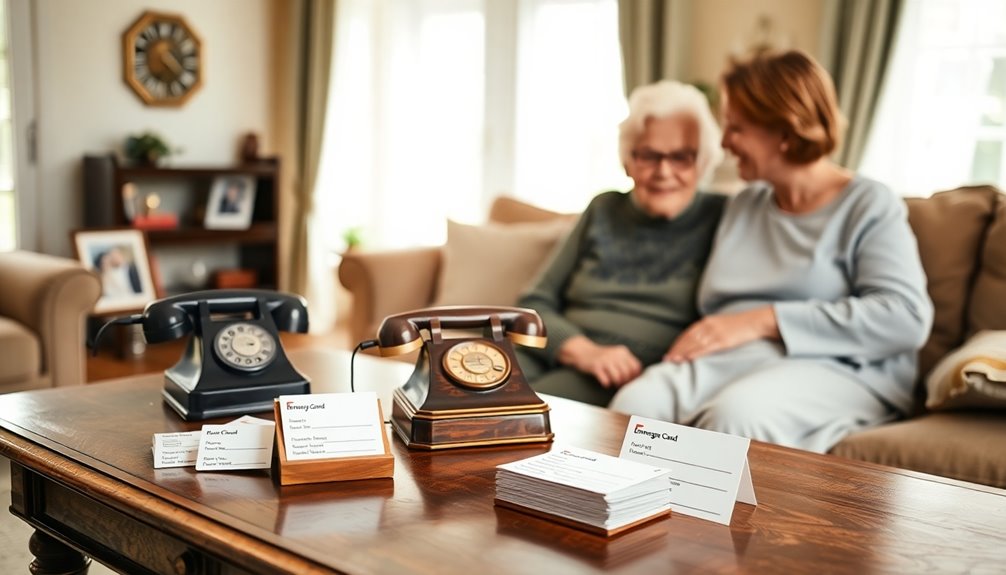
You need to keep emergency contacts easily accessible for quick help when it's needed most.
Consider using large print options for better visibility and make sure to update the information regularly.
Teaching seniors how to access these contacts quickly can make a world of difference in a crisis.
Emergency Contact Accessibility
How quickly can you access help in an emergency? Ensuring emergency contact accessibility is essential for your safety.
Start by maintaining a phone book or a digital list of contacts, including family, friends, and healthcare providers. Keep this information easily accessible, especially during high-stress moments.
Encourage using smartphone apps with emergency service buttons; they can connect you to help instantly. Regularly update your contact list to reflect any changes in family dynamics or healthcare providers.
Open communication with your loved ones and senior centers can also help you understand how to access these contacts quickly.
Educating yourself on how to use your phone or other devices effectively can make all the difference when you need urgent assistance.
Large Print Options
Large print options for emergency contact lists can greatly enhance safety and accessibility for seniors. By using large print, you guarantee that emergency contacts are easy to read, especially for those with visual impairments.
Maintaining a clearly visible phone book with these contacts allows for quick communication during urgent situations, fostering a sense of independence. It's crucial to encourage seniors to familiarize themselves with the location of their emergency contact list, enabling them to access critical information when needed.
Additionally, consider mobile apps that feature large icons and emergency service buttons, making it even easier for seniors to reach help quickly.
Prioritizing readability in emergency contacts considerably contributes to overall safety and confidence.
Regular Updates Necessary
Regular updates to emergency contact lists are essential for ensuring seniors can quickly reach the help they need.
Keep a phone book or digital list of emergency contacts, including family, neighbors, and health care professionals, accessible in urgent situations. Use large print for better readability, especially for seniors with visual impairments.
Encourage the use of smartphone apps with emergency service buttons to provide quick access to help. Regularly update contact information for family, healthcare providers, and emergency services to reflect any changes.
Teach seniors how to access these emergency contacts effectively, enhancing their independence and confidence. Keeping these details organized is a vital aspect of caregiver support, ensuring safety and peace of mind for everyone involved.
Social and Recreational Spaces
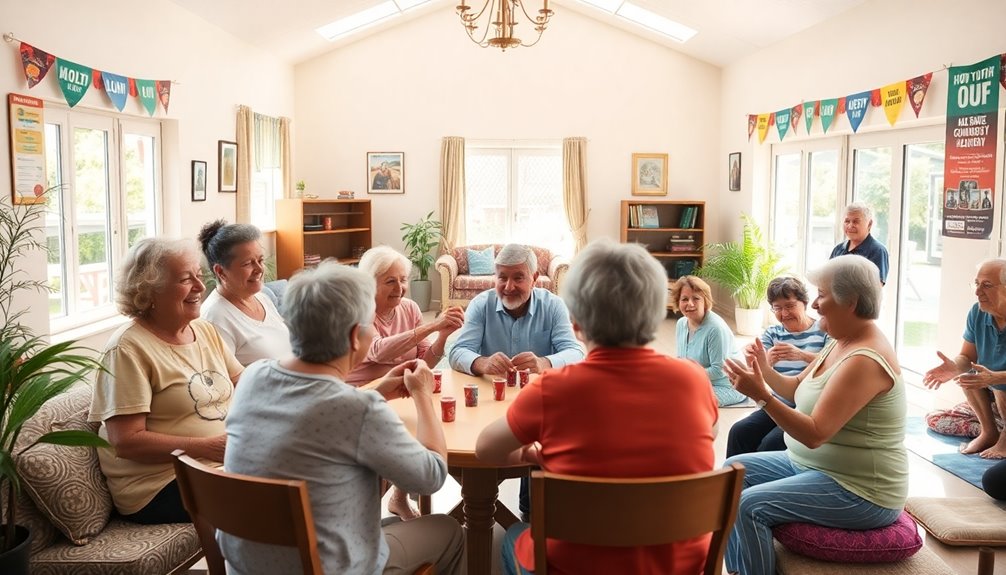
Creating social and recreational spaces that cater to seniors can greatly enhance their quality of life, as these environments encourage interaction and foster connections. By designing comfortable seating arrangements and cozy areas for reading or hobbies, you can reduce social isolation among elderly parents. Make certain these spaces are well-lit and accessible to accommodate varying mobility needs. Regular participation in group activities has been shown to improve mental health outcomes for seniors, further promoting their overall well-being.
Incorporate elements like puzzles, games, and art supplies to stimulate mental activity and creativity, as shared experiences can enhance intimacy among seniors. Offer a variety of group activities, such as exercise classes or crafting sessions, to engage diverse interests and promote socialization.
Personalizing these spaces with familiar decor and photos can also enhance emotional well-being, making seniors feel more at home while they engage in activities of daily living with peers. Additionally, creating comfortable seating arrangements can significantly improve the usability of these spaces for seniors with mobility challenges.
Medications

When managing medications for elderly loved ones, it's crucial to stay organized and informed to guarantee their health and safety.
Store medications in their original containers to prevent mix-ups, and use pill organizers to simplify adherence by organizing them by time of day.
Regularly review medications with healthcare providers to avoid unnecessary polypharmacy and verify each prescription is effective.
To enhance medication management, utilize digital reminders or alarms for timely intake, reducing the risk of missed doses.
Educate seniors about the importance of sticking to their regimens, as proper medication management can markedly improve their health and support their overall mental health. Additionally, consider collaborating on co-parenting plans as this can help create a supportive environment that includes medication adherence for elderly parents caring for children.
Emotional Well-being

Managing medications is only part of ensuring your elderly loved ones lead fulfilling lives. Focusing on their emotional well-being is equally important.
Personalizing their living spaces with familiar items and photographs can create a comforting environment. Open communication about their preferences allows your parents to express their feelings, fostering a supportive atmosphere.
Encourage social interactions with friends and family to combat loneliness, a considerable risk factor for depression in older adults. Involving them in decisions about their surroundings empowers them, boosting their autonomy and satisfaction.
Additionally, creating a routine filled with enjoyable activities and hobbies helps enhance their mood. Remember, by helping others, you can considerably improve their emotional health and overall quality of life.
Frequently Asked Questions
How Can I Encourage Social Engagement for My Elderly Loved One?
To encourage social engagement for your elderly loved one, start by inviting them to join community events or local clubs that match their interests.
You can also organize regular family gatherings or virtual meet-ups with friends.
Consider volunteering together, as helping others fosters connections.
Encourage them to explore hobbies or classes where they can meet new people.
Finally, be patient and supportive; your encouragement can make a big difference in their social life.
What Are the Best Resources for Financial Assistance in Elderly Care?
Imagine a garden where every flower needs nurturing; that's how you can think about finding financial assistance for elderly care.
Start by exploring local government programs like Medicaid or Medicare, which often provide essential support. Nonprofits and community organizations can also be valuable, offering grants and resources.
Don't forget to check with your loved one's employer; pension plans might offer benefits.
With the right tools, you can cultivate a secure future for them.
How Often Should I Check in on My Elderly Family Member's Well-Being?
You should check in on your elderly family member's well-being at least a few times a week, depending on their specific needs.
Daily calls or visits can help you stay informed about their health and emotional state. If they live alone or have health issues, more frequent check-ins might be necessary.
Always be attentive to any signs of changes in their condition, and don't hesitate to adjust your schedule as needed.
What Nutritious Meal Options Are Easy for Seniors to Prepare?
When considering nutritious meal options that are easy for seniors to prepare, think about simple dishes like oatmeal topped with fruits, scrambled eggs with veggies, or a hearty vegetable soup.
These meals require minimal cooking skills and can be prepared quickly. You might also try whole grain sandwiches with lean proteins and salads with mixed greens.
How Can I Find Professional Caregiving Services in My Area?
Finding professional caregiving services in your area can feel like searching for a needle in a haystack.
Start by casting your net wide—check online directories, local community centers, or hospitals. Don't forget to ask friends or family for recommendations; they might've golden nuggets of advice.
Once you gather options, interview potential caregivers to verify they fit your needs. Trust your instincts, and you'll find the right match for your loved one.
Conclusion
Just like a well-tended garden flourishes under the right conditions, your elderly loved ones can thrive with thoughtful care. By ensuring their environment is safe, social, and supportive, you're planting seeds of comfort and joy. Keep the paths clear like the sunlight that nourishes the blooms, and be their sturdy fence, protecting them from life's storms. With these expert-approved tips, you're not just caregiving; you're cultivating a vibrant, nurturing space for them to blossom.
